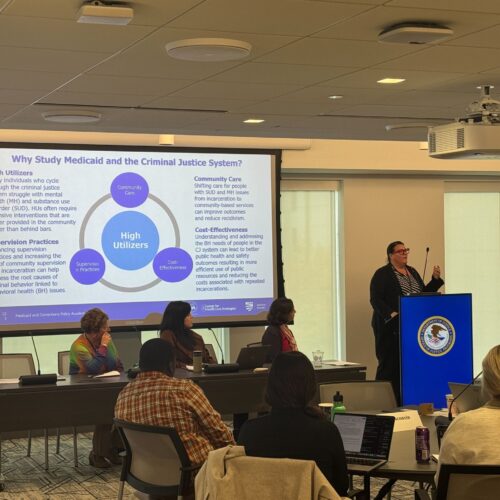Health, Mental Health, and Substance Use Disorders FAQ
Providing answers on relevant topics concerning health, mental health, and substance use disorders.
What health risks do people returning from prison or jail face?
In a study of more than 800 individuals released from U.S. prisons, nearly all—eight in 10 men and nine in 10 women—had chronic health conditions requiring treatment or management. In the same study, asthma, diabetes, hepatitis, and HIV/AIDS were the most common physical illnesses among people returning to the community; one-half of men and two-thirds of women had been diagnosed with one of these conditions.1 People in the study often had more than one type of health problem-conditions that they had when they entered the facility and that required ongoing attention upon release. Roughly four in 10 men and six in 10 women reported a combination of physical health, mental health, and substance use conditions.2
What is the prevalence of mental illness, substance use, and co-occurring disorders among incarcerated populations?
In a study of more than 20,000 adults entering five local jails, researchers documented serious mental illnesses in 14.5 percent of the men and 31 percent of the women, which taken together, comprises 16.9 percent of those studied. These jail rates are more than three to six times those found in the general population.3 Studies suggest that 10 to 15 percent of individuals in state prisons also have severe mental illnesses.4
The numbers are even higher for substance use. More than two-thirds of jail inmates are dependent on or abused alcohol or drugs—with little difference in the overall prevalence between men (68 percent) and women (69 percent).5 In a U.S. Department of Justice study, 53 percent of state and 45 percent of federal male prisoners meet the DSM-IV criteria for drug dependence or abuse.* Sixty percent of women in state prison and 43 percent in federal prison are estimated to be dependent on or abuse drugs.6 Other research has found as much as seven times the rate of substance abuse among jail inmates compared with the general population.7
Co-occurring mental health and substance use disorders are common. In prisons, approximately 30 percent of individuals with substance use disorders also have a major mental health disorder.8 Conversely, in jails, an estimated 72 percent of individuals with serious mental illnesses have a substance use disorder.9 In prisons, co-occurring disorder estimates range from 3 to 11 percent of the total incarcerated population.10
Why are healthcare services so critical for successful reentry?
Prisons and jails offer uniquely important opportunities for improving the health of individuals in the community by identifying health conditions and providing treatment and disease prevention programs to a large and concentrated group of individuals who often have complex and multiple health needs. Releasing individuals with untreated illnesses can create an additional financial burden on a local community’s public health system, particularly its emergency services. For individuals with substance abuse and mental health disorders, access to continuing community-based care upon release complements jail and prison interventions, supports an individual’s recovery and ability to comply with conditions of release, and leverages the financial investment made to treat the person while he or she was incarcerated.
Are some communities affected by the health conditions of returning individuals more than others?
Yes. In every state there are relatively few neighborhoods where a disproportionate number of formerly incarcerated individuals return from prison or jail; for example, despite housing only 3.5 percent of Miami’s population, a single ZIP code is home to 16.1 percent of all parolees in the city and 10.7 percent of all probationers.11 These “high-stakes” areas may lack the resources and services to address the health needs of reentering individuals—such as a higher prevalence of risky health behaviors, communicable diseases, and multiple complex illnesses. To exacerbate matters, in many of these communities, healthcare services other than hospital emergency rooms are largely inaccessible or underutilized.
Is focusing on addiction treatment for incarcerated individuals a fiscally responsible policy?
Yes. It is estimated that for every dollar spent on addiction treatment programs in the community, there is a $4 to $7 reduction in the costs related to drug-related crimes.12 An evaluation of California treatment outcomes found that with some substance abuse outpatient programs, about $12 is saved for every dollar spent on care by avoiding other healthcare costs (including emergency services) and by reducing drug-related crimes.13 A successful treatment episode yields many years of benefits, so most cost-offset studies are considered conservative estimates.14
Why is it important to screen and assess for mental health and substance use disorders at jail and prison intake and at release?
Prior to incarceration, many individuals have not received treatment, which may be due in part to the limited access in most communities to publicly funded treatment for substance use and mental health disorders. Estimates indicate that only 10 percent of individuals with substance use disorders receive treatment and 11.4 percent of individuals with co-occurring serious mental illness (SMI) and substance use disorders receive care for both.15 Screening and assessment on intake and release are critical personal and public health opportunities that must not be missed. They can detect people who have not been diagnosed or treated previously, and help ensure uninterrupted care for those who have. The information obtained through the screening and assessment process should follow the individual through the criminal justice system and be used to match the individual to appropriate treatment services while incarcerated and upon release. In general, individuals who are at high risk for committing a new crime and have more severe disorders require more structured and intensive treatment interventions before and after release, such as intensive outpatient treatment, day treatment, residential treatment, or therapeutic communities (TCs).† Conversely, low-risk and low-need individuals should receive less intense interventions such as peer support or mutual support aid groups that help people find and sustain recovery.16
What is the difference between screening and assessment?
Screening is a process for determining the likelihood of whether someone may have a substance use and/or mental health problem. The screening process does not identify the nature or severity of the problem, but determines whether further assessment is warranted. During the screening process administering staff use instruments that have a limited focus, simple format, and are quick to administer.‡ Although there are seldom any legal or professional restraints on who can conduct a screening, individuals who administer these instruments should receive appropriate training.
Assessment is a process to more fully define the nature of a problem and determine appropriate types of treatment. A basic clinical assessment consists of gathering key information and engaging the client to understand his or her readiness for change, problem areas, any diagnosis(es), disabilities, and strengths. The assessment process typically requires trained professionals with relevant certification in substance abuse and mental health treatment, advanced professional degrees, and specialized training in the use of particular assessment instruments to administer and interpret results.
For those screening and assessment approaches that require an interview, specialized training is needed in basic counseling techniques such as rapport-building and reflective-listening. Given the large proportion of cultural and ethnic minorities in the criminal justice system, screening and assessment approaches should consider influences of ethnicity, social class, gender, sexual orientation, race, disability status, socioeconomic level, and religious and spiritual affiliation.
How can correctional facilities improve healthy transitions to the community?
Few prison systems release individuals with medications or primary care referrals. Furthermore, many individuals leaving prisons and jails lack adequate health insurance.17 To strengthen the planning and pre-release process, correctional facilities should develop collaborative relationships with community agencies. For example, correctional staff and community health providers can share needs assessments and treatment information (within the parameters set by federal and state law; see questions on information sharing, below), determine which programs have treatment slots available, and identify programs that serve people with special needs. Taking these steps creates linkages and support between the time of release and placement in community services. This is particularly important for individuals with serious mental illnesses and others who require uninterrupted access to medication.§
How can continuity of care policies at release improve outcomes for people with substance use disorders and/or mental illnesses?
Without a careful pre-release planning policy that stresses aftercare, individuals with histories of substance use and mental health disorders are particularly vulnerable to resuming substance use or experiencing a mental health crisis in the months soon after release. For example, a study of reentering individuals in Washington state found the increased risk of death in the first two weeks after release is 12 times greater than among other state residents. In this study, the leading causes of death among formerly incarcerated individuals was found to be drug overdose, cardiovascular disease, homicide, and suicide.18 Ineffective continuity of care diminishes treatment gains and opportunities for successful reintegration, wastes treatment resources, and increases health and safety risks for the individual.19
What is health literacy education and why should corrections facilities and their healthcare partners promote it?
Health literacy is the degree to which individuals have the capacity to obtain, process, and retain basic health information needed to make appropriate decisions and to secure required services. Health-literate individuals are better able to understand instructions on prescription drug bottles, appointment slips, medical education brochures, doctors’ directions and consent forms, and negotiate complex healthcare systems. Individuals with limited health literacy incur medical expenses that are up to four times greater than patients with adequate literacy skills, costing the healthcare system billions of dollars every year in unnecessary doctor visits and hospital stays.20 Correctional healthcare services and correctional programming can enhance individuals’ health literacy before they leave the facility; this is especially important for individuals with infectious diseases.
What health issues do women tend to face when incarcerated and on their return to the community?
Since the early 1990s, the number of women held in state and federal prisons has increased more than six-fold.21 This produced an annual rate of increase for women that roughly doubled the rate for men in six of the first seven years of the new millennium.22 The increase in the number of incarcerated women behind bars, many of whom are mothers and the primary caregivers to their dependent children upon release, warrants greater attention to their health concerns.
- Interviews with incarcerated women indicate a lack of regular gynecological and breast examinations is common.23 The gynecological needs of incarcerated women are critical to their health and should be considered during incarceration and post-release.
- Nationwide, approximately half of women in state prisons and jails report having been physically and sexually abused in the past.24 This is consistent with research estimates for women generally: between 55 and 99 percent of women in substance abuse treatment (not necessarily limited to those in incarcerated settings) have had traumatic experiences; typically, childhood physical or sexual abuse, domestic violence, or rape.
Of these, between 33 and 59 percent have been found to be experiencing current post-traumatic stress disorders (PTSD). Trauma puts these women at greater-than-average risk for PTSD, high-risk pregnancies, life-threatening illnesses such as HIV/AIDS, and human papilloma virus infection (which may increase the risk for cervical cancer).25 Women are also at an increased risk for hepatitis C through the relationship between trauma, addiction, and injection use. A history of trauma greatly increases the likelihood that women will abuse drugs and alcohol.26 For people who abuse drugs intravenously, 50 percent to 80 percent will become infected with hepatitis C within the first six to 12 months of beginning to inject drugs.27
How can pre-release planning help elderly individuals address their healthcare needs?
The number of elderly (ages 50 and above) state and federal prisoners increased dramatically—by approximately 173 percent between 1992 and 2001.**,28 Pre-release planning is particularly important for those who are elderly, who are chronically or terminally ill, or who have other special or complex health needs.29 Older adults should be discharged with an appointment or referral to a healthcare provider in the community to which they are returning, and they should have a supply of medication sufficient to last until the community provider is seen.30 Individuals who are too frail or too ill to be candidates for home care will need assistance in finding placement in an appropriate community facility, such as a hospital, nursing home, or hospice.31
How can reentry initiatives address the behavioral healthcare needs of individuals who are homeless or in transitional housing upon release?
Individuals with behavioral health problems who are homeless or in transitional housing upon release benefit from assertive community treatment,* dual diagnosis programs, and supportive housing with on-site substance abuse and mental health services, access to medication, and social services.
When contacted by social workers and healthcare professionals, whether in shelters or on the streets, outcomes for the homeless are improved. A study of homeless people who were contacted by social workers and healthcare professionals on the streets and in shelters revealed that even individuals with the most severe disorders and who were the most reluctant to accept treatment enrolled in services and showed improved outcomes when served by an outreach team.32 For people in transitional housing, providing supportive services is effective in achieving residential stability, improving mental health and recovery from substance abuse, and reducing the costs of homelessness to the community.
Where should reentry planners direct people reentering communities who are uninsured or are not currently Medicaid-eligible for health services?
To ensure that individuals leaving correctional facilities are aware how to access services, reentry planners should familiarize themselves with local services that may be available through state health departments, local community health centers, teaching hospitals, and behavioral health agencies. Community health centers provide care regardless of insurance status or ability to pay. There are more than 1,200 health center organizations with more than 8,000 locations that can be found in urban, suburban, and rural communities in all 50 states, the District of Columbia, Puerto Rico, the U.S. Virgin Islands and Guam.
All health centers offer comprehensive primary and preventive health care. Many also offer dental, mental health, and pharmacy services. In addition, each state receives funding though the Substance Abuse and Mental Health Services Administration’s (SAMHSA’s) block grant program to provide services to individuals who are not eligible for Medicaid and who don’t have access to another form of insurance.†
What is the role of drug testing in supervising individuals on probation or parole with substance use and co-occurring mental health disorders?
Drug testing can help indicate when an individual with a history of substance use is having difficulties engaging in treatment or sustaining their recovery. Positive test results can be answered with graduated sanctions, which invoke less punitive responses for early and less serious noncompliance and increasingly severe sanctions for more serious or continuing problems.‡ The first response to drug use detected through urinalysis should be clinical—for example, an increase in treatment intensity or an alternative treatment. (Note that more intensive treatment should not be considered a sanction, but rather a routine progression in healthcare practice when a treatment seems less effective than expected.)
What should substance abuse treatment for individuals under criminal justice supervision address?
Treatment should address issues of motivation, problem solving, and skill-building for resisting drug use and criminal behavior. Lessons aimed at supplanting drug use and criminal activities with constructive activities and at understanding the consequences of one’s behavior are also important to include. Treatment and criminal justice personnel should work together on treatment planning—including implementation of screening, placement, drug testing, monitoring, and supervision—as well as on the systematic use of sanctions and rewards.
Research demonstrates that effective treatment and supervision models integrate criminal justice and addiction treatment systems and services. Examples of evidence-based practices in treating individuals with substance use disorder in criminal justice settings are listed below.
- Research has demonstrated that motivational interviewing and motivational enhancement therapies§ are associated with greater participation in treatment and better treatment outcomes. These outcomes include reductions in consumption, increased abstinence rates, better social adjustment, and successful referrals to treatment.
- Cognitive-Behavioral Therapy (CBT),** designed to change the thinking processes and patterns that foster criminal behavior, have been found effective in reducing recidivism and relapse among justice-involved individuals.
- Community-based drug treatment combined with intensive community supervision has been shown to significantly lower recidivism rates.33
- Contingency management strategies (such as the use of voucher-based incentives and rewards) can help support abstinence and promote progress toward treatment goals.
- Medication-assisted treatment for addiction (including methadone, buprenorphine, and naltrexone) can normalize brain function and help individuals remain in treatment.
How can community corrections and mental health agencies collaborate to improve outcomes for people under community supervision with mental illnesses?*
Programs that integrate community corrections responses with mental health treatment may reduce the risk of arrest and revocation and improve linkages to treatment and other services. Specialized probation and parole efforts that focus on people with mental illnesses integrate effective supervision strategies and community-based mental health treatment services. These include
- Forensic Assertive Community Treatment (FACT) is based on the ACT model but serves only people with histories of criminal justice involvement. It provides comprehensive, locally based treatment to justice-involved people with serious and persistent mental illnesses. Services—available 24 hours a day, seven days a week, 365 days a year—are highly individualized.FACT team members are trained in the areas of psychiatry, social work, nursing, substance abuse, and vocational rehabilitation. FACT programs’ outcome goals specifically address preventing arrest and incarceration. The majority of referrals come from criminal justice agencies. The program also integrates supervised residential treatment.
- Forensic Intensive Case Management (FICM), which mirrors ACT, but is less resource-intensive because caseloads are managed by single case managers instead of teams; services are not available 24/7; and access to mental health treatment is brokered (not provided in-house).
- Specialized Probation Caseloads, in which specially trained officers have smaller caseloads, collaborate extensively with community-based service providers, and employ problem-solving strategies when individuals under their authority do not comply with conditions of their supervision.†
Why should people reentering the community who need health care receive more routine assessment and treatment for past traumas?
Research shows that the vast majority of incarcerated people have histories of childhood trauma, especially childhood abuse. For example, a recent study of men incarcerated in a county jail reported that 59 percent acknowledged some form of sexual abuse occurring before age 13.34 A jail survey of women found 48 percent had a history of physical or sexual abuse and 27 percent reported rape.35 A history of abuse, as well as other forms of trauma, is especially likely for people in the criminal justice system who struggle with mental health and/or substance use disorders.
Healthcare providers need to consider past traumas when connecting reentering individuals with community-based care.‡ Reentry programs that recognize that trauma experiences are so pervasive in justice-involved populations can help individuals avoid re-traumatization and improve the safety of the correctional staff and those incarcerated. Treatment programs should recognize the individual’s need to be respected, informed, connected, and hopeful regarding his or her recovery. They should promote an understanding of how trauma can lead to particular symptoms. Participants in “gender-responsive treatment” have greater reductions in drug use, are more likely to remain in residential aftercare longer, and are less likely to be reincarcerated within 12 months of release.36
Practitioners should work collaboratively with other service agencies that are empowering to the individual who experienced trauma. Training can provide staff with the most effective approaches for intervening with people who live with the effects of trauma.§
What role do peer support services play in recovery from substance use disorders, mental illnesses, and co-occurring disorders?
Peer-based recovery support is the exchange of nonprofessional, non-clinical assistance to achieve long-term recovery. Peer providers assist an individual with developing coping and problem-solving strategies to improve the self-management of his or her addiction or mental illness. Peers may contact the individual frequently in-person and by phone to offer support and assistance, and to encourage engagement in support groups and other services. They may also organize structured leisure and recreational activities that provide opportunities for participants to practice social and coping skills.
For substance abuse, this support is provided by people who have experience (and who may be credentialed) assisting others in initiating recovery from severe alcohol and/or other drug-related problems, maintaining recovery, and enhancing the quality of personal and family life in long-term recovery.** The services may precede formal treatment, strengthening a peer’s motivation for change, or follow treatment, supporting relapse prevention.*
For mental illness, peer-based recovery services (sometimes called consumer-operated services) are provided by individuals with personal recovery experience. When combined with traditional mental health services, a majority of studies show peer support improves mental health outcomes.37 Some studies also show improvement in clinical outcomes, such as reduced hospitalizations. When working as a substitute for traditional mental health providers, peer providers typically perform as well as non-peer providers furnishing the same non-medical service.38 Peer support is often provided by consumer-run organizations, in which most or all staff and the majority of board members have a history of mental illness.†
How can families assist in promoting positive health outcomes?
Families and pro-social networks can play a critical role when their loved ones are involved in the juvenile or criminal justice system. Studies have found that increased positive contact with family during incarceration can reduce the likelihood of recidivism.39 In addition to playing an important role in addressing addiction and encouraging reentering individuals to find and keep jobs, families can provide other motivation for change. However, it is important to evaluate the influence that family members may have on an individual’s substance use or criminal activity, which are often intergenerational issues.40 It is important to pay particular attention to the distinct issues that women may encounter upon release when connecting with former partners, who may have had a role in their substance use or may have committed acts of domestic violence. Conversely, any risk to family members posed by re-integrating an individual who has been incarcerated should always be evaluated as well.
Programs including family members in treatment during incarceration and after their release can produce positive results for individuals, families, institutions, and communities.41 Social connections that are maintained during the period of incarceration can be an important resource to help individuals achieve positive post-release outcomes.42 Most formerly incarcerated individuals believe that family support is an important factor in helping them stay out of prison.
Are criminal justice, treatment, and service providers prohibited from sharing information because of federal and state privacy laws?
No. Criminal justice and health professionals sometimes are misinformed about what federal regulations mandate regarding how information is shared and under what circumstances. HIPAA, together with regulations promulgated by the U.S. Department of Health and Human Services (HHS), establish federal standards for the privacy and security of protected health information, including mental health information. The confidentiality of alcohol and drug abuse patient records is governed by 42 CFR Part 2. These regulations apply to all programs that are “federally assisted.”
HIPAA and 42 CFR Part 2 rarely explicitly prohibit the exchange of information. Rather, they provide guidance about the conditions under which information can be shared, although HIPAA is typically more permissive than 42 CFR Part 2.
HIPAA and 42 CFR Part 2 set a minimum standard for protecting and securing protected health information. If state law is more restrictive (i.e., is more protective of privacy) than these federal laws and related regulations, then the state law governs. A local, county, or state counsel can advise whether state law or federal law is more restrictive in a given area. Although practitioners must always be sensitive to the distinct facts of a specific case in which sharing information is desired and which laws apply, the following general principles help determine which area of law is likely to apply in a given situation:
- State law is almost always stricter than HIPAA in providing for the confidentiality of mental health records. Therefore, in determining the legal rules for a particular exchange of mental health information, counsel may want to consider state law first.
- In contrast, the federal regulations for the confidentiality of substance abuse and alcohol treatment (42 CFR Part 2) are rarely exceeded by state law. Rather, state laws usually mirror the federal regulations. Therefore, in determining the legal rules for a particular exchange of substance abuse or alcohol records, federal law usually will be the starting point for the analysis. This means that in treatment programs working with individuals with co-occurring mental and substance use disorders, 42 CFR Part 2 will usually be the most relevant for practitioners, rather than HIPAA, because it is generally more protective of confidentiality than HIPAA.‡
What can agencies do to facilitate information sharing?
Agencies involved in criminal justice-behavioral health collaborations will likely interact regularly and can facilitate exchanges of information and data through a number of mechanisms. They can form partnerships through contractual arrangements, including “business associate agreements” and “qualified service organization agreements.”§ Agencies in collaborative relationships also can create or use forms such as uniform authorization/consent forms (clients can give advance permission for sharing information among designated agencies and the circumstances under which it can be exchanged) and standard judicial orders.
After the appropriate permission has been obtained, practitioners should generally share the minimum information necessary for the allowed purpose, as opposed to sharing all information at their disposal. There are important exceptions for healthcare providers who are sharing information for treatment purposes, to avoid the loss of life, for a reason required by law, or who are sharing information with the patient or consumer.**
Why is it so important to help individuals apply for public benefits prior to release from prison and jail whenever possible?
Lack of health insurance is a significant problem for individuals after their release. A large study of 650 men returning from prison found that 78 percent of newly released individuals had no public or private health insurance two to three months after community reentry, and 68 percent still had no insurance by eight to 10 months after reentry.43 The failure to identify eligible applicants or reinstate Medicaid benefits before release leaves a medically and psychiatrically vulnerable population uninsured during the months following release. This critical period is associated with an increased risk of medical problems, re-arrest, and death.44 In addition, failure to facilitate Medicaid and other federal and state benefits can result in more costly care over the long term.
What federal benefits are available to people after incarceration?
People with health, mental health, and/or substance use disorders who are returning to communities from correctional facilities can sometimes use Medicaid, Social Security Disability Insurance (SSDI), and Supplemental Security Income (SSI).
Medicaid is a shared state and federal program that supports access to healthcare services for people who have disabilities and are low income. It is also available to families of these individuals. Payments are sent to providers as reimbursement for any medical care provided to those who are covered. States are currently barred by federal law from extending Medicaid coverage to adults without dependent children based on income levels alone. Instead, coverage requires that a person who is low income also suffers from a disability.45 Some individuals are automatically qualified for Medicaid benefits in most states; members of these “mandatory eligibility groups,” as the Center for Medicaid Services (CMS) describes them, include SSI recipients, limited-income families, and pregnant women whose family income is at or below 133 percent of the federal poverty level (FPL).46 Other individuals may receive Medicaid coverage under state-specific criteria. These “optional eligibility groups” usually serve people who are chronically disadvantaged, such as institutionalized individuals with limited resources and income, low-income children, and pregnant women not covered under mandatory eligibility group criteria.47 Starting in 2014 (or earlier, if a particular state opts to accelerate implementation), the Patient Protection and Affordable Care Act (PPACA), commonly known as health reform, will expand Medicaid eligibility to include all individuals who live under 133 percent of the FPL.*
SSI and SSDI are programs run by the Social Security Administration to provide additional avenues for low-income people with disabilities to gain necessary assistance. SSI provides monthly payments to low-income individuals to assist with purchasing necessities such as food, clothing, and shelter. Coverage is available to people who have a disability, exceed 65 years of age, or are blind. Individuals who request assistance through SSI must also establish through application materials that they have limited incomes and resources.48 SSDI also provides monthly payments to low-income individuals to assist with purchasing necessities; it also provides cash assistance to spouses and dependent children of people receiving SSDI benefits.49
When people are incarcerated, what happens to their federal benefits?
Federal benefits are usually suspended or terminated upon incarceration. Whether or not an individual has benefits suspended or terminated depends on the type of federal benefit, length of incarceration, and federal and state policies.
States are not required by federal law to terminate Medicaid benefits for individuals entering correctional facilities, but they often do. A 2000 study found that 46 states terminate (rather than suspend) Medicaid benefits for people who are incarcerated in jail.50 If Medicaid benefits are terminated while a person is incarcerated, he or she should begin the (re)application process several months prior to release to ensure continuity of care. Friends on the outside, officials in the correctional institution, and the local social services office can assist with the application to reinstate benefits.
SSI and SSDI benefits are not required by federal or state law to be terminated upon incarceration. Benefits can be suspended, rather than terminated, depending on length of stay. SSI payments are suspended when a person is incarcerated for fewer than 12 consecutive months, and are terminated when a person is incarcerated for 12 or more consecutive months.51 SSDI benefits are generally suspended if a person is incarcerated for more than 30 continuous days. SSDI benefits to children and spouses can continue while the main beneficiary is incarcerated.52
Corrections officials or their partners should create a mechanism to suspend rather than terminate benefits where possible to ease the process of reinstating benefits upon release. For a summary of state and county best practices for providing access to benefits for people who are incarcerated, including suspending rather than terminating benefits, please see Bazelon’s “Best Practices: Access to Benefits for Prisoners with Mental Illnesses.”
When can a person (re)apply for federal benefits?
Once the individual’s release date is known, he or she should identify and notify the appropriate official at the facility to start applying for Medicaid, SSI, and/or SSDI. If officials notify the local Medicaid office and the Social Security Administration in advance of release, benefits can be available more quickly.
People incarcerated for more than 12 months must (re)apply for Medicaid and SSI benefits.† Officials and people who are incarcerated should inquire about the eligibility determinations and application policies in their state well in advance of the release date.‡ Families may be able to assist the process as well by ensuring the necessary documentation and application materials are collected.
The Social Security Administration allows a correctional institution to help enroll eligible individuals in SSI and SSDI if the institution has what is called a “pre-release agreement” with the local Social Security office. With a pre-release agreement in place, corrections officials can submit an application on behalf of the returning individual before his or her scheduled release. In this case, the institution should notify Social Security prior to release if the individual is likely to meet the requirements for SSI or SSDI benefits. If a person is applying for SSDI, the local Social Security office will work with correctional staff to gather medical documentation regarding the disability.
Social Security can process an application before anticipated release so that benefits can start as soon as possible after release. If the institution does not have a prerelease agreement, the incarcerated individual can contact Social Security directly to apply once the release date is known. Generally, proof of release is required, as well as a social security number and benefit application. Medical documentation of a disability is required for those applying for SSDI. Corrections officials and family members can assist the individual with the application process by obtaining and submitting relevant application materials.
Does a substance use disorder prohibit access to SSI or SSDI benefits?
No, not necessarily. The Social Security Act was amended in 1996 to state that an individual may not be eligible for SSI or SSDI benefits if drug addiction or alcoholism (DA&A) is material to the disability determination. (DA&A is “material” if the individual would not be deemed disabled if the use of drugs or alcohol were to stop.) People who have other disabling conditions that are independent of their drug addiction or alcoholism (e.g., a serious mental illness) are still eligible for benefits. Because most states link SSI and Medicaid beneficiary actions, the loss of SSI or SSDI benefits due to the DA&A benefits elimination will automatically trigger the loss of Medicaid coverage as well.
With healthcare reform, will more individuals returning from prisons and jails be eligible for Medicaid?
Yes. Currently, justice-involved people, many of whom are low-income adult men, do not qualify for Medicaid unless they meet stringent disability requirements and are unable to work. This leaves many of those exiting correctional facilities uninsured.
Starting January 1, 2014 (or earlier, if a particular state opts to accelerate implementation), individuals with household incomes at or below 133 percent of the FPL will be eligible for Medicaid regardless of disability status. For single adults, the eligibility ceiling equals an income of approximately $14,400 per year; for a family of four, this comes to about $29,300 annually.§
The Congressional Budget Office has estimated that 16 million newly eligible individuals are projected to enroll in Medicaid.53 Another analysis has determined that strong state-level outreach and enrollment efforts could reach as many as 23 million new enrollments.
A positive school experience, where a child feels secure, is essential for their well-being. However, for many children…
Read MoreWhen returning to their communities from criminal justice settings, people with behavioral health needs face barriers in accessing…
Read More Supporting Children of Incarcerated Parents: Reimagining School and Community Collaboration
Supporting Children of Incarcerated Parents: Reimagining School and Community Collaboration
A positive school experience, where a child feels secure, is essential for their well-being. However, for many children with incarcerated parents—one in 14 in the U.S.—school can feel far from safe due to stigma, trauma, and a lack of understanding.
Read More Bridging Communities and Correctional Systems: Q&A with CSG Justice Center Advisory Board Member Commissioner Nicholas Deml
Read More
Bridging Communities and Correctional Systems: Q&A with CSG Justice Center Advisory Board Member Commissioner Nicholas Deml
Read More
 Assigned to the Cloud Crew: The National Incarceration Association’s Hybrid Case Management for People with Behavioral Health Needs
Assigned to the Cloud Crew: The National Incarceration Association’s Hybrid Case Management for People with Behavioral Health Needs
When returning to their communities from criminal justice settings, people with behavioral health needs face barriers in accessing basic needs—including food, housing, employment, transportation, education, clothing, and substance use and mental health services—which increases their risk of experiencing a crisis.
Read More Meet the Medicaid and Corrections Policy Academy Mentor States
Meet the Medicaid and Corrections Policy Academy Mentor States
New Hampshire Department of Corrections Commissioner Helen Hanks presents at the Medicaid and Corrections Policy Academy in-person meeting.
Read More Taking the HEAT Out of Campus Crises: A Proactive Approach to College Safety
Taking the HEAT Out of Campus Crises: A Proactive Approach to College Safety
The sharp rise in school shootings over the past 25 years has led school officials across the U.S. to take a closer look at ways to keep students safe. For Chaffey College in Rancho Cucamonga, California, a tragic incident at a nearby university hit close to home and spurred campus leaders to revisit their own school’s threat assessments and crisis responses.
Read More










